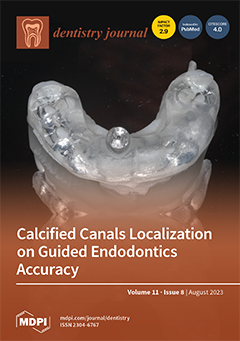Introduction: The aim of this prospective descriptive study was to analyse the possible variables associated with marginal bone loss in rehabilitated implants (Proclinic S.A.U, Zaragoza, Spain) two years after their prosthetic loading. Materials and Methods: Three clinical centres collaborated for a period of two years after the prosthetic rehabilitation of the implants (Proclinic S.A.U, Zaragoza, Spain), in which marginal bone loss and the possible associated variables were evaluated. The collection form comprised different variables throughout different stages of the implant procedure, from implant insertion to the subsequent prosthetic rehabilitation, over a two-year period. Data of the patients and implant characteristics were studied. Statistical analysis was performed with SPSS for qualitative (univariate logistic regressions, Chi2 test, and Haberman’s corrected standardised residuals) and quantitative variables (Kolmogorov–Smirnov test). Results: The total study sample consisted of 218 implants (Proclinic S.A.U, Zaragoza, Spain). The sample presented a frequency of 99 men (45.4%) and 119 women (54.6%). The mean age of the patients among the reported cases was 58.56 ± 10.12 years. A statistically significant association was found between marginal bone loss 2 years after prosthetic rehabilitation placement and several variables, including age (under 55 years, 0.25 mm ± 0.56; 55–64 years, 0.74 mm ± 0.57; over 65 years, 0.63 mm ± 0.55;
p < 0.0001), gender (female, 0.74 mm ± 0.61; male, 0.34 mm ± 0.51;
p < 0.0001), bone quality (D1, 0.75 mm ± 0.62; D2, 0.43 mm ± 0.57; D3, 0.65 mm ± 0.60;
p < 0.01), implant diameter (up to 4 mm, 0.49 mm ± 0.58; more than 4 mm, 1.21 mm ± 0.30;
p < 0.0001), prosthetic connection type (direct to implant, 0.11 mm ± 0.58; transepithelial straight, 0.67 mm ± 0.57; transepithelial angled, 0.33 mm ± 0.25;
p < 0001), implant model (internal conical, 0.17 mm ± 0.24; external conical, 0.48 mm ± 0.61; external cylindrical, 1.12 mm ± 0.32;
p < 0.0001), prosthetic restoration type (full denture, 0.59 mm ± 0.59; partial denture, 0.50 mm ± 0.85; unitary crown, 0.08 mm ± 0.19;
p < 0.05), and insertion torque (>35 N/cm, 0.53 mm ± 0.58; <35 N/cm, 1.04 mm ± 0.63;
p < 0.01). Conclusions: At 2 years, marginal bone loss following prosthetic rehabilitation was shown to be influenced by multiple factors. Correct implantological planning is of vital importance for successful rehabilitation.
Full article






